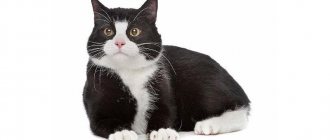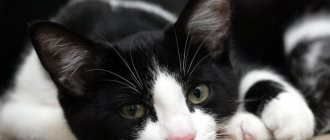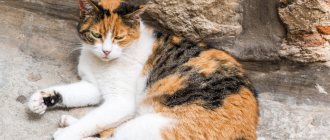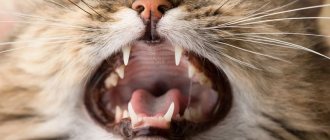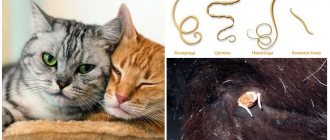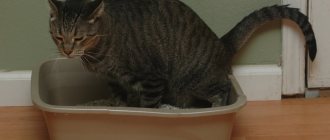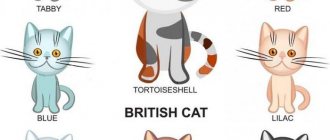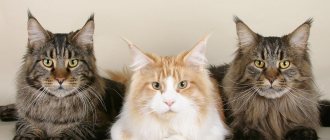Home » About cats » About Black and white cats and cats
Black and white cats are called “Bicolore” - (two colors). These animals are considered quite persistent, but they are easy to get along with. They can easily do without human interaction. This color is more common in outbred cats, but there are several breeds with a similar color: British, Van, Angora, Persian and Siberian.
Usually black and white “bicolor” color can be found in cats of the British breed. They often give birth to kittens of different shades: from lilac and white to black and white. They are called harlequin cats. The main color of representatives of this breed should prevail over the second. The number of spots should not be more than three.
A bit of genetics
Two basic colors are responsible for the entire rich color palette of cat colors (except white):
- black;
- red.
They are formed under the influence of the pigment melanin, which includes two chemical varieties:
- zumelamine - gives the coat a black color;
- pheomelamin - produces red color.
The genes responsible for the appearance of red (O - orange) or black (o - not orange) are located on the X chromosome:
- cats have two X chromosomes (XX);
- Cats have one X chromosome and one Y chromosome (XY).
The kitten inherits one chromosome from each parent: from the mother - X, from the father - X or Y.
Just like in humans, female cats have a set of XX chromosomes, and males have XY chromosomes.
Three colors that a cat can have:
- OO - red;
- oo - black;
- Oo - tortoiseshell.
If both X chromosomes contain O, the cat will be red, if O, it will be black, and if Oo, the cat will be two-colored.
For a cat that does not have the O gene on the Y chromosome - OY or oY. Accordingly, cats can only be red and black. Tortoiseshell cats appear only as a result of a gene failure and are almost always sterile.
If the parent X chromosome carries the O gene, the cat will be red, and if O, the cat will be black.
The white color stands apart. Rather, it is not even color, but the absence of pigment.
Genetics of black and white color
The black and white cat's coat is called black bicolor (two colors). Bi-colored cats are sometimes called meglais, from the English "magpie."
The bicolor color was recognized by European associations in 1969. After this, an active period of breeding bicolor cats began. Before this, pets with double colors were considered a genetic defect.
The dominant S gene is responsible for spotting in cats. Sometimes it works so actively that the white spots on the coat merge into one continuous spot, and the animal becomes completely white. If the gene is not expressed in full force, two-color colors are obtained.
Piebald color can be inherited, with the location and size of the spots changing.
Even in the same litter, kittens with the same bicolor color are not born. Each fur pattern is individual, just like the papillary pattern on a person’s fingertips.
To get a meglaye litter, breeders mate two bicolor parents or a black and white cat with a tortoiseshell cat.
Two-color cats - signs
Every shade has its own symbolism. Including when it comes to the color of the animal.
- A smoky gray cat's coat helps owners deal with stress and smoothes out conflicts.
The usual gray color gives wisdom, red promises prosperity and the favor of fortune to ambitious owners.
The signs about white and black cats are especially categorical:
- Snow-white pet - concentrated healing power;
- Black - development of hidden talents, intuition, magical abilities, protection from evil.
The contrasting combination of shades in bicolor is not just beauty, but also a huge benefit for the owner. Signs about two-color cats relate to different color options:
- The combination of red and white, for example, is characteristic of the strongest “accumulators”.
Pets receive energy directly from the Sun, accumulate it within themselves, and, if necessary, generously share it with the owner - cure diseases or help achieve success in their chosen field.
Black and white color standards
There are three types of black and white color, fixed in the relevant standards.
Table: classification of black and white colors
| Color type | Black and white color code | Main characteristics of color | Type of distribution of white color in a cat's color according to FIFE standards | External differences |
| Wang | n01 |
| The color of Van cats suggests that it contains 5/6 white |
|
| Harlequin | n02 |
| The color of a harlequin cat suggests that it contains from 1/2 to 5/6 white; it is an intermediate type of white distribution between van and bicolor |
|
| Bicolor | n03 |
| The color of bicolor cats suggests that it contains from 1/3 to 1/2 white. In this case, the bicolor color must be separated from the “with white spots” color, which requires only a slight inclusion of white |
|
Sometimes individual white spots on a cat's black coat appear without the participation of the dominant S gene. Their manifestation is due to the influence of both the most recessive form of the white piebald gene and a completely independent gene.
Markings appear in the form of white "medallions", "buttons" or spots in the groin. Such spots are acceptable for native breeds, but for selective breeds they are considered a reason for disqualification.
Gallery: types of black and white colors
Van cats have an almost white coat, two colored spots on the head and a completely colored tail.
In a harlequin-colored cat, colored spots occupy approximately a quarter of the body and can form any fancy patterns. When the dark color begins to dominate over the white, the color is called bicolor
Black and white cats: just the facts
Contents hide
Black and white cats: just the facts
One small question, dear friends: how often have you encountered black and white cats in your life? Let's not even talk about the fact that you were or are the owners of such pets? If you are interested in the author’s answer, then please: I see black and white cats almost every day, and at one time (albeit for a very long time) I owned a cat and a cat of such a “classic” color. I suspect you gave roughly the same answers. There is only one conclusion - black and white cats have become widespread throughout the world. Let's get to know them better!
In the USA, the black and white color is called “tuxedo cats”. Surely the Americans saw a certain similarity between the cat's color and the classic black men's suit, which is worn with a white shirt. Initially, the phrase “tuxedo color” meant a black cat with a white chest and white slippers. Then in the New World they began to call all black and white cats this way. The phrase is also used in the Old World, but has limited distribution. Hand on heart, it is almost impossible to find two completely identical black and white cats. Animals will differ in their drawings, “patterns”. Some cats will be more white with black spots. Some are black with a white chest. As they say, there are a lot of options.
Black and white cats are widespread. Our British colleagues are sure that 70% of all cats in the world are black and white. Well, let's take their word for it. However, depending on how you count! There are even exotic options: for example, completely white cats with “antennae” similar to those of the German Fuhrer. There are completely white cats with black ears. My own cat once had only a charming black nose. That’s what they called her – “Blacknose”. Well - if all these pussies are written down in black and white, perhaps we will reach the “British” 70%.
Black and white color is characteristic of a number of breeds. Many cat lovers sincerely believe that black and white coloring is the destiny of “yard” Murziks and Museks. No - this is nothing more than a delusion. Let's give examples: British Shorthair, Maine Coon, Manx, all Rexes without exception - all these breeds can be black and white. By the way, the black and white Maine Coon is very rare. It looks great, believe me!
Of course, some breeds “physically” cannot be black and white - take the Russian Blue or Siamese cats. But if you delve deeper into the wilds, you can come up with impressive results: many mixed Siamese cats already have a black and white color!
Black and white cats are not often adopted as pets. Some fans find them too “simple” or something... It’s very difficult to find the right words. Shelter workers say the same thing: most often tabby-colored cats find new owners. I personally knew a kind black and white cat named “Gentleman” - he’s a real “tuxedo”. An immaculate shirt, white slippers, a formal suit... Alas, the Gentleman grew old in an orphanage...
Black and white color is determined genetically. Let's not use obscure scientific terms! Let’s just note that a certain gene is responsible for the formation of the “tuxedo”. It’s called the “white spotted gene.” This gene does not specify color as such; it simply prevents black color from forming in "patches" on the cat's body. The principle of its action is exactly the same as that of the gene “responsible” for the solid white color; the difference is that it only “works” in certain areas. No other cat colors are formed in this way.
Some black and white cats have tabby areas. The most beautiful silver tabbies are also, in fact, black and white tabbies; they are quite rare. There are other black and white fancy "patterns" - like chinchillas or black smoky cats.
All black and white kittens are born with blue eyes. Which by the age of one month “transform” into green or golden. However, an adult black and white cat with blue eyes is not at all uncommon.
Black and white cats purr the loudest. The world record for purring belongs to a black and white cat named Merlin. In the presence of representatives from the Book of Records, the inconspicuous pussy emitted a record 67.8 dB, which is much louder than any average cat.
Some world famous cats were black and white. In particular, many remember the “conflict” between the black and white cat Palmerston from the British Foreign Office and his colleague Larry from the Prime Minister’s residence at 10 Downing Street, which took place in 2016 and was widely covered by the world press. Interesting - Google it!
Physicist Sir Isaac Newton, playwright William Shakespeare, and composer Beethoven owned black and white cats. During the presidency of Bill Clinton, a black and white cat also took up residence in the White House. An ordinary black and white cat is the pet of the current American Vice President Mike Pence.
Images of black and white cats are also depicted in world fiction (let us mention, in particular, the world-famous work of T. S. Eliot “The Old Possum’s Book of Practical Cats”).
The black and white cat even received a combat medal! A relatively little-known fact from the history of World War II. The Mary Deakin medal was awarded to the black and white cat Simon, who “served” on the British sloop of war “Amethyst” - he selflessly protected the food supplies on the ship from hordes of rats.
We hope you enjoyed our story! Perhaps now you will look at black and white cats with different eyes. And you might even want to shelter some of them!
We ask our readers – owners of black and white cats – to let us know about you. Tell us what is so special about your pets?
Photo: pixabay.com
Bicolor cat breeds
Black and white coloring is found in both “mongrels” and purebred animals. There are a number of breeds in which bicolor kittens are quite common.
British cat
Bicolor color among British cats is quite widespread and can have many different variations. Black and white representatives of this breed look especially impressive. The contrasting color, reminiscent of a tuxedo, gives them an aristocratic look.
British bicolors must have white muzzle, collar, hips and “slippers” on their paws
In the professional language of felinologists, white spots in the British are called Piebald Spotting (“piebald spotting”).
In addition to the officially recognized bicolor colors, the British have a mitted color. Its distinctive feature is a white stripe running from the chin to the chest, a white groin and belly, and sometimes you can see white “socks.” Mitted is considered a breed fault.
Basic color requirements for two-color British cats:
- uniform distribution of color spots;
- unblurred boundaries between contrasting patterns;
- absence of moire and unpainted hairs;
- eye color: orange;
- amber;
- In Van and Harlequin cats, heterochromia is acceptable.
The character of British motley cats is as contrasting as the color of their coat. These cute creatures allow you to do anything to yourself that does not humiliate their feline dignity. The British love their owners sincerely and tenderly, but will never force their love on them. They are always nearby, but at a certain distance. Pets are unobtrusive, clean and smart. Cats enjoy the presence of their owners, but calmly tolerate their absence. British Bicolors are quite tolerant of animals and small children, but at times they need privacy.
Video: British bicolor kittens
Scottish cat
Scots have an impressive range of colors, in which the bicolor color has found its niche. The general requirements for white piebald colors for the Scots are the same as for the British - the correct distribution of white and colored areas. True, Scottish folds are a little inferior to their British relatives in the clarity of borders and symmetry of the pattern.
The black and white pattern gives the Scottish cat an extraordinary charm
Breed characteristics characteristic of bicolor Scots:
- eye color: copper;
- rich orange;
- heterochromia is acceptable.
Experienced breeders notice that the character of Scottish dogs is in some way interconnected with the color of their coat. Blue individuals are quite obstinate. This is explained by the fact that British genes “rage” more strongly in them. And animals of black and white color are more affectionate and flexible.
In general, Scottish cats are distinguished by a stable psyche, gentlemanly restraint and an accommodating, peace-loving character. They are unpretentious in everyday life and are well disposed towards children and animals. Scots are not aggressive, but can fight back if necessary. Independent by nature, pets of this breed do not like close tactile contact and show signs of love themselves. They don’t get bored alone if you leave them everything they need.
Persian cat
Persian cats are famous not only for their luxurious coat, but also for their rich color palette. Black and white Persians are by no means lost in this motley list.
Until recently, quite strict requirements were imposed on the two-tone color. In the modern world, the only necessary condition for bicolor Persians is that two contrasting colors be in a certain proportion .
Pedigree differences of the Meglai Persian cat:
- spots should not occupy more than 2/3 of the total area, white wool - more than 1/2;
- eye color: copper;
- dark orange;
- blue;
- heterochromia is acceptable.
- pink;
Black bicolor Persians are deservedly popular among cat lovers
Phlegmatic and sedentary, Persian cats do not need frequent active games, although occasionally they are not averse to chasing a ball around the house. Instead, they can spend hours looking out the window or lying on the sofa. Persians are absolutely good-natured and unforgiving creatures that fit perfectly into the company of people and animals living in the same territory. Cats of this breed need constant care, so they will become faithful companions for lonely and underemployed people.
Video: adorable bicolor Persian
Maine Coon
In addition to their impressive size and memorable appearance, Maine Coons are famous for their wide range of colors. Bicolor colors are quite common in this breed.
Maine Coons are a native breed, so there are many more acceptable black and white combinations than other cats.
Classification of black and white Maine Coon color:
- white gloves - the presence of white “socks” or “slippers” on the paws;
- snow-white medallion - the presence of white marks on the chest that resemble a shirtfront;
- colored buttons - the presence of small round spots with clear outlines;
- bicolor - dark spots dominate over white ones;
- harlequin - white color takes up no more than half of the area;
- van - the coat is almost white, with the exception of a few spots and a completely colored tail;
- tuxedo - a set of white gloves and a white medallion, visually reminiscent of the men's outfit of the same name.
External differences of bicolor Maine Coons:
- any shades of the iris are allowed;
- The paw pads and tip of the nose are in harmony with the shade of the animal.
Despite their large size, the character of Maine Coons is quite friendly, calm and affectionate. They easily get along with pets and children of any age group. Preference is given to one owner, who, thanks to his intelligence and attention, is understood at a glance. Cats are incredibly active and playful, so they need a spacious room for an active life.
Video: bicolor Maine Coon
Angora cat
Previously, all representatives of the Turkish Angora breed had exclusively snow-white fur and incredible ultramarine eyes. Felinologists decided to expand the range of Angora colors and, by infusing the blood of other breeds, bred cats of various color combinations, including black bicolor.
Black and white Angoras look no less impressive than their monochrome relatives
Breed characteristics of the black and white angora:
- implies the presence of: a light inverted V between the eyes;
- snow-white paws, chest, muzzle (white belly and shirtfronts are allowed).
- blue;
The Angora cat is a very friendly and restless animal. Cats have a fine mental organization and cannot tolerate rudeness and violence. They are very sociable and thrive in the company of other animals. Young children are treated with tolerance, but they are not shown much love. Pets are distinguished by their innate intelligence and quick wit. They treat all family members with respect, but preference is given to one owner.
Canadian Sphynx
Canadian sphinxes, despite their extraordinary appearance, have long found their admirers. The delicate wrinkled skin, the bewitching look of expressive eyes and large ears, like those of a bat, attract special attention to the breed.
In Canadian Sphynxes, not only the barely noticeable pubescence on the body is colored, but also the skin
In the bicolor color of the Canadian Sphynx, any ratio of contrasting colors is recognized. The black shade of suede skin is closer to an intense gray color, and the white shade is closer to light pink or cream.
External features of bicolor sphinxes:
- the color of the iris of the Sphynx's eyes is not tied to the main color of the coat and can be anything;
- The paw pads and mirror match the main color of the skin (pigmentation in the form of black spots is acceptable).
Sphinxes have a cheerful and curious disposition. They get along well with children and patiently endure even involuntary rudeness. They often choose their favorite owner and prefer to spend all their time with him. Without proper attention, pets begin to suffer, may refuse to eat and even get sick. Sphynxes are one of the most talkative animals. They accompany all their actions with sounds. It is not advisable for busy people to have such pets.
Siberian cat
The Siberian cat is the real pride of Russian felinologists. This luxurious breed comes in the most incredible colors. Fluffy two-color beauties are deservedly popular.
The main requirement for the double colors of the Siberian cat:
- correct distribution and ratio of white and colored areas;
- eye color of black bicolor Siberians: green;
- yellow.
- pink;
Siberian black bicolors have the most incredible, cheerful and expressive colors
Siberian cats have a proud and independent character, but with the right approach they become the most devoted and affectionate friends to their owners. Siberians amaze with their intelligence - they understand family members literally, although they rarely speak up themselves. These are active and sociable pets. They enjoy communicating with children and animals living under the same roof. Siberian cats do not like familiarity, so you can win their love only with delicacy and tact.
Kurilian Bobtail
Kurilian Bobtails are a relatively young breed, but the animals can compete with the most common cat “brands”. Bobtails are easily recognized by their short, docked tail, shaped like a pompom.
The play of white and black colors creates the most unusual patterns on the bobtail’s fur.
Almost all colors are allowed by the standard. Black bicolor for animals is not a rare exotic color.
Breed differences of black and white bobtails:
- white inclusions of varying sizes are allowed in any area of the body;
- black and white pet eye color: green;
- yellow;
- blue;
- heterochromia is acceptable.
Kurilian Bobtails are called dogs in cat form. Indeed, in their behavior they resemble dogs. Pets are brave, fearless and have a loyalty to their owner that is atypical for cats. Bobtails easily find contact and get along well with animals and children. According to numerous statements, representatives of this breed are able to relieve stress and fatigue with their presence.
Munchkin
Munchkins are the shortest-legged members of the cat family. In the breed standards for dachshund cats, all colors and combinations are acceptable. This is another selective breed where black and white bicolor is very popular.
The ancestor of the munchkins was a black and white cat, so bicolor coloring is very common in this breed
Characteristics of black bicolor munchkins:
- black bicolor is most often presented in approximately the same combination of dark and light areas;
- in bicolor, the pigment of the eyes does not depend on the color of the animal’s coat;
- The color of the paw pads and nose mirror depends on the main color of the cat.
Munchkins are cheerful, active and inquisitive animals. Cats have incredible intelligence that helps them keep themselves occupied. Munchkins are very loyal to children and animals, they become attached to all household members, but they choose one owner for themselves. Pets love to be in a large and noisy company, but absolutely do not suffer alone.
Many munchkins have a tendency towards kleptomania: they, like magpies, love to hide shiny and small things in secluded places, so that they can later take them out and play with them.
Manx
Manx are the aboriginal inhabitants of the Isle of Man. Their main external feature is the absence of a tail. Manx cats have a downy, soft coat that feels like rabbit fur to the touch.
Among the representatives of this breed, any colors are possible, except those that appeared as a result of selection. The black bicolor is recognized by the association and is in great demand among Manx breeders and fanciers.
Breed characteristics characteristic of black and white individuals:
- eye color: yellow;
- tea;
- orange;
- green.
Black and white bicolor favorably emphasizes the beauty of the Manx's down coat
Manxes are very sociable and social pets. They find a common language and communicate well with all household members. Cats love small children and willingly participate in their games. Representatives of this breed are extremely affectionate, peaceful and unforgiving. Manxes are the best option for those who need a loyal friend and reliable companion.
Character of two-color cats
A cat's temperament directly depends on its color. It is believed that black and white cats have an ideal character. This is due to the heredity of the strong character of dark-colored cats and the softness of light-colored beauties. The bicolor cat is revered by the English and Scots. They perceive a meeting with a handsome man of this color as a blessing. In addition, they are very popular in Russia. These animals are stress-resistant, assertive, but easy to communicate with. They feel great even without human interaction and are very smart. They always understand the owner’s mood.
If they see that the owner is busy, they will not pester him. They usually don’t hold a grudge against the owner; they won’t take revenge on a person for an insult. They have this property from white cats, as well as their calm disposition. They are distinguished by amazing obedience and imperturbable composure. These cats love to play. This quality is stronger in them than in white or black cats. They are quite independent. Unlike other cats, they will not get their way in any way. Their dignity and pride will not allow this.
These cats get along well with people. They are capable of causing tenderness even in an overly serious person, not counting flexible and kind people. This is due not only to their wayward character, but also to their ability to remain calm.
